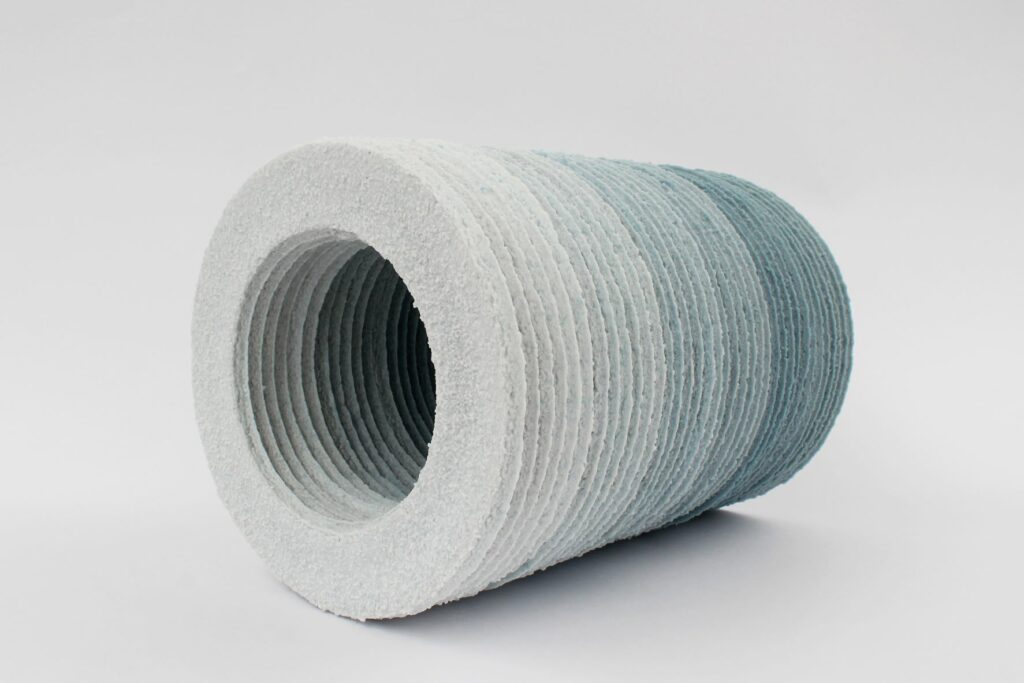Desislava Stoilova, Tubes, 2022/Rémy Hans, Maison bleue, 2022/Photo © Ouvert la nuit
Desislava Stoilova (born 1983) discovered glass by chance when she was studying art in France in 2002. She was so fascinated by it that she chose to make it her medium of artistic expression. After creating glass paintings, she began making fused glass sculptures before experimenting with glass paste — and tackling all its attendant technical challenges. As Stoilova is well aware, working with glass is an ongoing process of striving to understand this challenging material, an endeavour that pushes her to surpass herself. She enjoys exploring the myriad possibilities offered by this material, a far from easy task due to the unbending yet incredibly fragile nature of glass. Working with glass powders over time, she was able to create shapes and textures thus breathing life into the ‘glass dust’ to create meaningful work. Stoilova travels around the country and to cities observing and noticing details that most of us would find insignificant, such as derelict buildings, corrugated iron, the textures of walls, pipes, bales of hay, etc. She photographs, observes again, draws and then refines the shapes and images that become the narrative lines of the story she wants to tell. She brings to life to the ‘little things’ that form the identity of a landscape as well as our own.

Her sculpture does not only participate in the mise en abîme (a story within a story) of the object under scrutiny, but also creates a record of a moment suspended in space-time, through the title she gives to her work Stoilova shares her observations, memories and feelings about the passing of time and the changing landscape. Her sculptures exude strength and grace, fragility and power. The soft, diaphanous colours invite reverie.
Rémy Hans (born 1994) is a Belgian artist who also shares his vision of the world with us. Hans grew up in Borinage, a region with a once glorious industrial past of which all that remains are traces, now reclaimed by nature. Inspired by this strange juxtaposition, he creates drawings, sculptures and texts that show us what is, what no longer exists, and the dissonance that seems to exist between nature and humankind. You will not see any people in his work, yet their presence is clearly perceptible through buildings and visible changes that have been made to the landscape.
For his work entitled “de Mémoire et de Forme”, industrial glass was at the centre of his creative process. Hans does not transform the glass, but uses it as it was originally created. Abandoning his legendary blue pencils, Hans began experimenting with cyanotypes (a photographic printing process) to fix on paper (in multiple gradations of cyan blue) the glass objects that were witnesses of the industrial overproduction that shaped the latter half of the 20th century and the beginning of this millennium in particular. Using pieces of industrial glass manufactured in the Charleroi Basin, Hans has created futuristic architectural structures that suggest certain optimism about the future of our world. Using his imagination, he creates a vision of humanity that is more respectful of the earth and the resources it gives us.
Hans and Stoilova share the same goal: to question more deeply the impact of humankind on its environment. Through their work, they share their views and perceptions of our world while also creating a “record” for future generations.
MUSÉE DU VERRE
Site du Bois du Cazier
Rue du Cazier, 80
6001 MARCINELLE
Opening times
Tuesday to Friday from 9:00 a.m. to 6:00 p.m.
Saturday and Sunday from 10:00 a.m. to 6:00 p.m.
Information 00 32 (0) 496 599 214 / mdv@charleroi.be